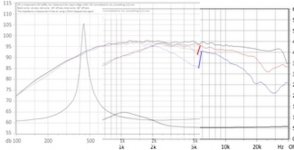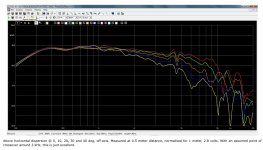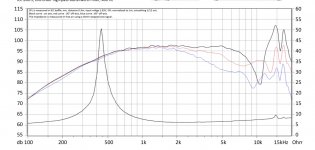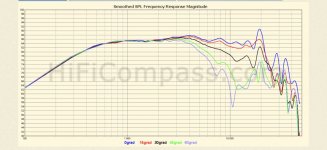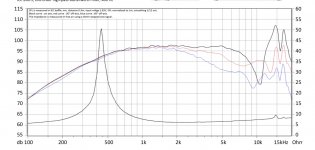Most driver datasheets don’t include 60deg off axis. So when you look at these you get the illusion that the off axis is worse than it actually is. Personally I never listen 60 deg off axis anyways.
That’s where what’s seen on paper, and real world results can conflict. People pay far too much attention to what matters little, and ignore what matters most. That’s not how it will look in the real world with summing. I’ll be using a 4th order not a brick wall.
Last edited:
Not so abrupt of course but there will be a problem/disruption there...
When FR on axis is flat, phase is flat and distorsion is low - then its only directivity left 😉
//
When FR on axis is flat, phase is flat and distorsion is low - then its only directivity left 😉
//
You could say 95% of speakers have a problem there then. The off axis dispersion will still be better than most speakers. 60 deg off axis response only matters for like a Dolby Atmos ceiling or sidewall speaker. The 30 deg off axis will blend perfectly fine. Sound will be way better because all the mids to lower treble will be coming from 1 driver that handles them superbly, without a crossover messing it up. The crossover point will be in a region much less sensitive to human ears. And distortion will be reduced, along with power handling, and maximum SPL will increase.
Last edited:
Yes they have. But some don't and they are good in my opinion. You will be surprised by how much of the off axis you listen to in a normal living room situation. I'd say that it is fair to claim that much more energy will hit your ears from reflected sound than the direct radiated. If you think about it - just a tiny ray hits your ear without a bounce and then the contribution from walls, ceiling, roof comes barging in 🙂 - everything no later then 30ms (a 10 meter delay) is just merged together in a combined experience due to the Precedence effect.
I agree on the strategy of having 400-4k being produced by one and the same driver - path to success.
//
I agree on the strategy of having 400-4k being produced by one and the same driver - path to success.
//
Most speakers do have this as a problem the really good ones do not. To say that this isn't important, or matters little, is clearly incorrect. Manufacturers go to great lengths to solve this problem with engineering. KEF, Revel, JBL, Genelec, Neumann etc and almost any design that incorporates a waveguide.
To say you don't listen at 60 degrees off-axis is also incorrect. You listen to the on-axis as much as the off-axis because you're in a room. The reflected sound contributes significantly to the perceived tonal balance.
Having one driver covering the most 'critical range' is a fallacy too. It was created, largely, from a bygone era where DIY loudspeakers were very poorly designed and hobbyists didn't have easy access to measurement and design software. Basically if you try and design your own speaker, and make a really bad job of it (which happened all the time). If you've crossed over outside of the ears most critical range and have used well behaved drivers, it's less likely to sound bad. Crossing outside the ears most sensitive range was purely a damage limitation exercise.
The point is that a well designed crossover, smack bang in the middle of the ears most sensitive range, cannot be heard. Big jumps in directivity, on the other hand, can melt your ears off.
To say you don't listen at 60 degrees off-axis is also incorrect. You listen to the on-axis as much as the off-axis because you're in a room. The reflected sound contributes significantly to the perceived tonal balance.
Having one driver covering the most 'critical range' is a fallacy too. It was created, largely, from a bygone era where DIY loudspeakers were very poorly designed and hobbyists didn't have easy access to measurement and design software. Basically if you try and design your own speaker, and make a really bad job of it (which happened all the time). If you've crossed over outside of the ears most critical range and have used well behaved drivers, it's less likely to sound bad. Crossing outside the ears most sensitive range was purely a damage limitation exercise.
The point is that a well designed crossover, smack bang in the middle of the ears most sensitive range, cannot be heard. Big jumps in directivity, on the other hand, can melt your ears off.
Lots of manufacturers also like to have fancy plots for marketing purposes as well. I base my decisions on 27 years of experience, rather than marketing material from Harman, or anyone else. But that being said, I’m building active speakers so only takes a few minutes to change the frequency and slope.
The directivity will be perfectly fine. I sent Stan an email to ask what he thinks is the best crossover frequency. Since he designed these drivers to work together, I’m sure he will have an idea about it. Ill share what he responds with.
There’s far more jumps than just directivity when you crossover in the most critical band. They might be able to be compensated for on paper in marketing brochures, but not in the real world.
Here’s the ATC soft dome mid everyone crosses over at 3.5k. It’s 6 dB down at 40 deg off axis at 3.5k. The Belisma is about 3dB down 40 deg off axis @ 5k. ATC speakers must be crap.
Attachments
Last edited:
They're not crap, but they have a lot of compromises.Here’s the ATC soft dome mid everyone crosses over at 3.5k. It’s 6 dB down at 40 deg off axis at 3.5k. The Belisma is about 3dB down 40 deg off axis @ 5k. ATC speakers must be crap.
But yeah, I wouldn't buy them.
It's not up or down at x deg. necessarily. You think hard and long about directivity and then you define what you want for your system. It can be flat or rising or... then, but only then, do you do your choice/design of drivers, enclosure, x-over, placement wrt. to room surfaces to get your desired directivity.
//
//
The higher you go up in frequency, the less directivity matters. Much more important with a 2 way, especially with an 8” driver.
The higher you go up, the more a 8" will beam... its like nature has seen to that it shall not be easy 😉
//
//
Yes that’s exactly why paying attention to directivity in a 2 way design with an 8” driver is important. Because it starts beaming in the most critical range of hearing.
- Home
- Loudspeakers
- Multi-Way
- Some speaker driver measurements...
